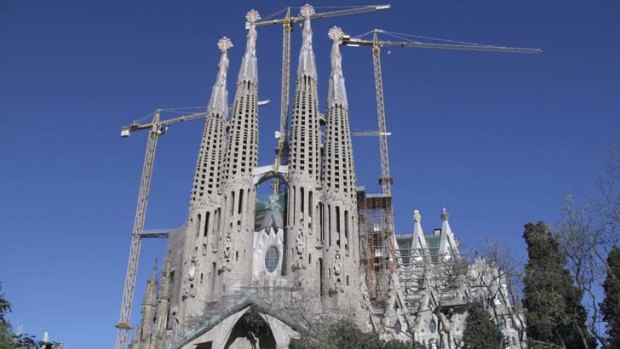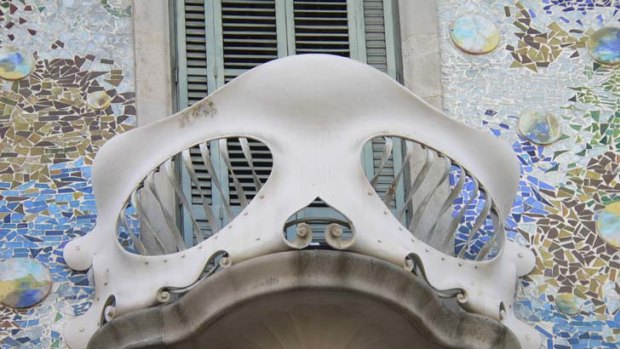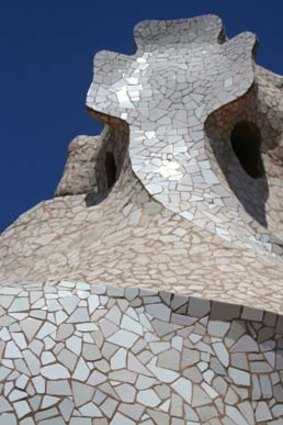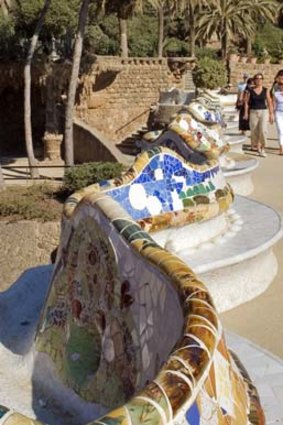By Janet Keeler

Construction on Sagrada Familia began in 1882.
On a recent quick visit to Barcelona, I crammed Antoni Gaudi's major works into one day, thanks to two guided tours with a break for lunch in-between.
A more leisurely traveller, or an architecture student, could spend weeks studying the mosaics of recycled ceramics, the wrought-iron forgery and the stained-glass windows that are the hallmarks of Gaudi architecture. Any number of books on Gaudi and his freewheeling designs could entertain and educate for hours over strong coffee in a streetside cafe.
I had long wanted to see the wavy facade of Casa Batllo (pronounced Bot-YO) and the landmark Sagrada Familia, and I was not disappointed.

Casa Batlo: There are no straight lines here; even the windows are curved, framing the Passeig de Gracia in an organic, natural way.Credit: Beverley Johanson
But they are quite real and part of the fabric of Barcelona's independence as the capital of Catalonia. That independent streak is exemplified in the works of Gaudi (1852-1926), the leading architect in the Catalan Modernism movement of the late 19th century and early 20th century.
There is much written about Gaudi and his work. He vowed a bachelor's life after being scorned in love as a young man. As he grew older, he became more sullen and serious about his work, living his last years in the Sagrada Familia, which was granted basilica status last year by Pope Benedict XVI.
And Gaudi was a famously slow and meticulous creator, choosing not to use pencil and paper to sketch, instead constructing 3-D models as blueprints. He made the plans for one multistoried church out of string. Upside down. As the string structure was hanging, he studied its reflection right-side up in a mirror in order to complete building plans. It took him 10 years alone to make the model.

A chimney atop Casa Batllo.Credit: SUsan Weigall
Industrialist and Gaudi benefactor Eusebi Guell was fed up with his slowpoke architect, and pulled financing for the church in his company town outside Barcelona, which is why the church of Colonia Guell is only one storey high.
The Colonia Guell church is one of several Gaudi works that have been granted World Heritage Site status by UNESCO. I glimpsed some, such as Casa Mila and the Palau Guell, from the street, but was able to tour four others: Sagrada Familia, Casa Batllo, Parc Guell and the string-model church at Colonia Guell. Some impressions:
Colonia Guell

Parc Guell was designed by Catalan architect Antonio Gaudi for Barcelona industrialist Eusebi Guell between 1900 and 1914.
A quick 12km bus ride outside Barcelona brought us to Colonia Guell, a small village that grew up around the textile factory owned by the industrialist Guell. The factory has long been closed and it is now an industrial park. Most of the people who live here commute into the city for work.
While the textile industry that created the village is gone, Gaudi's church (1898-1914) draws daily tour buses. We walked around the narrow streets with Artur, who gamely answered questions about real estate. Seems Americans are always curious about the cost of properties.
The church itself, up a steadily rising lane, seemed to spring incongruously out of nowhere. The walkway and overhead structures outside the church are studded with storytelling mosaics, including a depiction of the Stations of the Cross. Inside, I felt like I had happened upon an ancient grotto rife with religious meaning but without the typical statuary and symbolism of most Christian churches. The sanctuary has been described as a "womb with a view" and it does exude cosy comfort.
Basilica de la Sagrada Familia
Gaudi's opus, which he worked on steadily the last years of his life, could easily be named Church of the Holy Cranes. No fewer than seven massive construction rigs surround the unfinished church and have been a part of the skyline for decades. Only their positions change.
When Gaudi died in 1926 - run over by a tram in the city - just a quarter of the massive project was complete. Work resumed in the 1950s. Completion has been tentatively set for 2026, the 100th anniversary of Gaudi's death - or maybe a couple of years later.
Sagrada Familia is one of Spain's most popular tourist attractions, with several million people visiting every year. We followed our guide Elizabet through the crowd, attempting to keep our footing as we gazed up at the Gothic spires and detailed friezes, while working around the beggars.
Inside, the ornate facade gave way to a vaulted, modernistic interior with a crucified Jesus hanging from a circular, lighted frame. This was a 1987 addition. Despite the patchwork appearance thanks to different artists and architects, there has been a great attempt to preserve and respect Gaudi's vision while allowing the building to evolve.
Visitors can walk or take a lift to the top of one of the towers on the east side of the church, but time prevented our group from taking in the view.
Parc Guell
On a hill overlooking Barcelona and the Mediterranean beyond is the 12-hectare park that was intended to be a gated housing community. After Guell died, the park was given to the city, and besides the hustle and bustle of La Rambla, the city's pedestrian thoroughfare, this is the best people-watching place in Barcelona.
It's always busy with tourists following guides with umbrellas, and others relaxing on the mosaic stone benches that nestle into the curving wall. The dragon motif at the Casa Batllo becomes a slithering serpent here. Hardly intimidating, the undulating nooks create a social place to sit and talk. If only I had had more time.
I walked through the viaducts and curved, cavelike pathways that snake throughout the park.
Casa Batllo
My favourite of all the sites is the five-storey home renovated in 1904 for another wealthy Barcelona industrialist, Josep Batllo. Since a face-to-face is not possible, I'd settle for one of the remaining private apartments on the top floors, close to the dragon's back and the clever chimneys on the roof.
Casa Batllo is on the "Block of Discord" on the exclusive boulevard Passeig de Gracia, with its clashing architecture styles. Whoever designed the rather plain corner building adjacent to Casa Batllo must have given up. Who could compete with Gaudi's oddball artistry?
Climbing the stairs to the top floor and feeling with each step like we were getting closer to the heart of Gaudi's genius. The windows had been shrunk to filter the harsh Mediterranean light. The tiles became a deeper blue to mimic the sky.
There are no straight lines here; even the windows are curved, framing the Passeig de Gracia in an organic, natural way. We were a couple of storeys above the street, but a bunch of leagues under the sea, it seemed, thanks to stained-glass bubbles all around us.
Gaudi's work is just mind-blowing.
IF YOU GO ...
WHERE TO STAY: Hotel 1898 on La Rambla, where a double room is about 174 euros ($A236) a night (www.hotel1898.com). It is just a five-minute walk to Plaza Catalunya, a major public transportation, shopping and dining hub and a place where some tour groups meet.
There are many hotels along La Rambla, which is close to the cruise port, running the gamut from luxury hotels to low-budget, communal hostels. Prices vary.
GAUDI TOURS: Barcelona Guide Bureau conducts daily tours of many sites in the city on air-conditioned buses.
There are two separate tours of the Gaudi architecture sites; one includes the Basilica de la Sagrada Familia and Parc Guell at 45 euros ($A61), and the other takes tourists to Casa Batllo and the church and village at Colonia Guell for 53 euros ($A72). Tickets to attractions are included in the price.
There is also a combo tour, which included both itineraries for 76 euros ($A103). Check barcelonaguidebureau.com for times and days because there are some seasonal changes.
WHERE TO EAT: If you stay on La Rambla, you'll find plenty of places to eat, including La Boqueria, the famous market. It is not open at night or on Sundays, but try to make it for lunch or a snack. Seafood, meat, fresh produce, coffee and all sorts of tapas are here. Pull up a stool at one of the counters and eat as they do in Spain. We ate late-night tapas at the new Cachitos Tapas & Copas (Rambla Catalunya, 22; cachitosbcn.com). Excellent watermelon sangria, gazpacho and grilled calamari. A good selection of tapas for two plus a cocktail is about 48 euros ($A65).
HELP: Barcelona & Catalonia (2009) by Cadogan Guides and Barcelona & Catalonia from DK's Eyewitness Travel Guide series (1999) are both helpful.
MCT
Sign up for the Traveller Deals newsletter
Get exclusive travel deals delivered straight to your inbox. Sign up now.